#larval earth
Photo

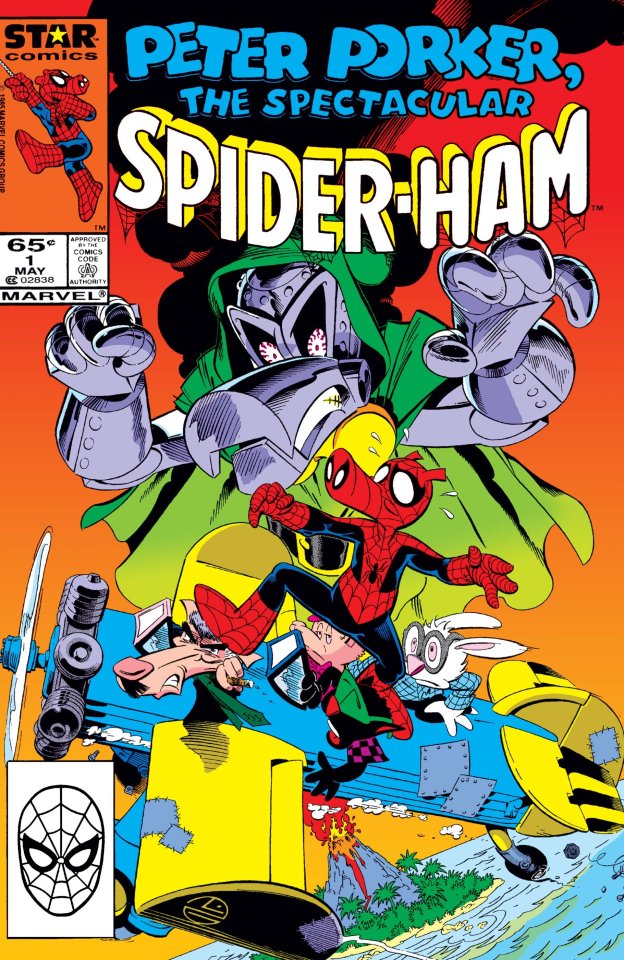
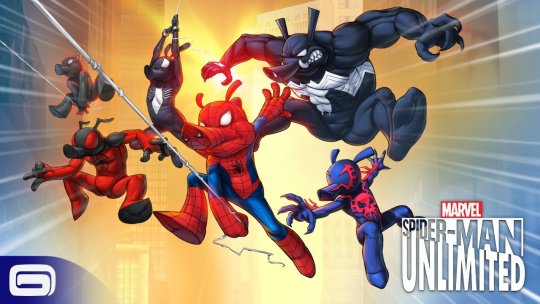
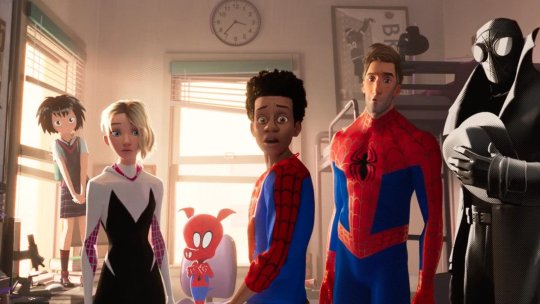
spreadsheet cleanup
SPIDER-HAM
It skews the numbers when I don't clean up spreadsheet entries already on @MCOCwishlist or in @MarvelChampions.
~225 comics [ComicVine 234; Fandom I count* 217]
27 variants
9 other games
movie & TV
Before his MCOC debut, his Wishlist spot was 100% merited
- Other Gabe
Spider-Ham’s record with us (mostly before he was added to MCOC)
Visit Spider-Ham’s official Ch “Ham”-pion Spotlight
Notes
*Marvel.Fandom.com does not have a page dedicated—separately from other Peter Parkers—to all the variants of Peter Porker. The Fandom Peter Porker page just has a link to Peter Parker. This is understandable: Peter Porker variants are just the realities in which Peter Parker is a pig. But it meant manually finding all the pig versions of Peter Parker from Peter’s Fandom page, recording the number of appearances of each, and adding them up. So there’s no way to link to one page from which I got the cited number.
#Peter Porker#Earth 8311 Larval Earth#anthropomorphism#swine#Spiderverse Hero#spiderverse#Peter Parker#Spider-Man: Into the Spider Verse#champion obscurity#obscurity check#series Other Gabe's spreadsheet cleanup Fall 2022#tone humorous#Spider-Geddon#Spider-Ham#Spider-Man#Spider-Men
5 notes
·
View notes
Photo




Centaur Aliens
Lifespan: 80 years
Adult weight: 500-1000 kg
Adult height: 2.5-4 meters
Visual range: near infrared to blue
Diet: Obligate hypercarnivores
Centaurs' evolutionary ancestors were savanna pack predators who used ambush to hunt prey, nomadically following prey animal herds as they traveled round the global continent every year. Modern centaurs emerged when they started to use tools to help with hunting and land management, eventually resulting in some groups settling down and becoming reliant on fishing, animal agriculture, and food preservation to survive. Centaurs remain obligate hypercarnivores, meaning approximately 70% of a healthy diet is meat and animal products, but they opportunistically supplement their diet with grain, starchy tubers, and small amounts of roughage and vegetation.
Similar to humans, centaurs have a bisex reproductive system with an inseminator sex and gestator sex who gave birth to live young, but functionally are more akin to Earth's marsupials. Centaur’s distant ancestors had larvae that lived in the soil like grubs before pupating into adults, and their viviparous silk eating clade first emerged after parental care of the larval stage evolved. While other members of their clade have development and pupation both happen in-utero, centaur litters leave the womb early and feed on their parent’s nutritive silk until they are large enough to pupate, spinning a cocoon on their parent’s back. They emerge as an imago, resembling a miniature adult with the physical capacity of an six-week old kitten.
Centaurs are pseudo-eusocial, with a social structure hierarchy somewhat similar to meerkats. At its most basic level a clan consists of one matriarch, a female who is responsible for bearing the clan's young; the entourage, who are the matriarch's partners and usually mostly male; and the clan's "workers," who are not involved in reproduction. These non-reproductive clan members are generally either the matriarch's children, childless relatives, or individuals married in for their skills or political purposes.
Read more about centaur biology on my janky eternally work-in-progress website here, or look at the old centaur reference post here.
PATREON | STORE | Runaway to the Stars
#rtts centaurs#speculative biology#jayart#runaway to the stars#yaaaay finally an update to the janky ass old reference post
6K notes
·
View notes
Text

Karraguls' homeplanet has large swathes of tropical wetland, and has had a relatively stable climate compared to Earth. As such, there was little need to evolve mechanisms against dessication; shell-less eggs and a swimming larval form are common among terrestrial "vertebrates".
Ancestrally, eggs were laid in cup or pod shaped sessile organisms that collected rainwater. Some populations still continue this tradition, but others would rather not have their children exposed to the elements, predators, and parasites outside. Handmade cots or domestic indoor varieties are slowly replacing the old way.
425 notes
·
View notes
Text

Uniima larvae come in large numbers but high mortality rate as these onigiri have to compete to become juveniles even in the egg case.
They start off with an egg wall. Their bodies are still clumbs of cells that slowly fill up the inside of the 'egg', consuming the included nutrients. Once they are ready, the baby grows it's own wall for the first time and 'hatches'.
After this the larvae molts as it grows with a new wall each time. During the whole larval period the shed skin sticks to the white. If adults don't clean them up, you will see multiple torn layers on top of the white, which can cause issues.
The white grows a straw. A somewhat brittle organ compared to that of ancestral larvae but functional enough to pierce under another whites wall (especially in the side seam). The larva actively feeds itself using this, though the food has to be liquid enough to get through the straw. They don't smell or see to search for food and will just wiggle the straw around until they can slurp. These triangles are mostly fat and liquids with other tissues in the center and thowards straw.
When they completely lose the straw (the entrance to it reforms), they start eating with their new mouth. At this point they also start making noise with their nostrils. Adult Uniima are sensitive to this much more than to the visual cuteness of the larva. This is often when adults start claming individuals to raise.
As the creature grows and gains complexity inside its own wall, it's new molts allow for use of more developed parts - anal cavity opens, ear cycles appear, eyes get bigger and closer to the wall surface, "mouth hands" with leathery pads emerge.. and lastly it's whole legs with fingers (often just silhouettes of feet show up rather then whole fingers or they are webbed).
After it's last stage and sufficient amounts of food, the white goes dormant to metamorphosise. This can take a week and less as most juvenile components are already in place.
The larval stages of Uniima can differ in length depending of environment - temperature, humidity, lack of food...
The average time from birth to metamorphosis is around 3 and half earth months.
The images here are not fully up to scale. Most larvae grow more between the stages but it's also not impossible for it to be to scale. I would just consider this larva a runt of the litter.
#art#speculative biology#digital art#uniigiri#artists on tumblr#artwork#worldbuilding#speculative evolution#spec bio#uniima#white#alienart#xenobiology#uniima larvae#alien life cycle#ask#original alien species#yummy food#some cultures will eat them at a growth stage yes#or just have them raw right away to regain energy
370 notes
·
View notes
Text
The Fix's Facts
The Big Guy:
-For every snake, there is one snake dick. Snakes have 2 dicks. (said thrice)
The Scattered Mind:
-The tails on a swallowtail butterfly's wings don't serve any aerodynamic purpose. They're there so birds will grab them, at which point they'll break off and the swallowtail can escape.
-Eyes can't be itchy. They, unlike the membranes around them, don't have itch receptors.
-More than half the bones in your body are in your hands and feet.
F For Freezer: (and for facts!)
-The urethra contains taste receptors
-When eagles grip onto something, they have to flex a muscle to let go. An eagle can hold onto something so hard that even after it dies, it never lets go.
-Most of the pyramids on Earth are in Sudan.
-Pelicans have three stomachs, one of which is just for bones.
-Acids are easy to detect, oxygen and carbon dioxide are not. But when carbon dioxide meets water, like it does in our blood, it creates carbonic acid. This means our bodies can detect the presence of carbon dioxide, but not the presence or absence of oxygen.
If we are deprived of oxygen, we have no idea that that is happening as long as we are breathing out carbon dioxide. If we are not breathing oxygen, we just go to sleep and die. But if we allow the CO2 to build up, we panic. We flail. We break. Until finally, we die.
Grappling With Death:
-People can have constipation so bad that it will back up and impact their vagus nerve. As they are eliminating that impacted stool, it can have an effect on the nervous system so great that they forget who they are. Constipation-related amnesia. A woman in Tokyo forgot who she was for 8 hours.
-Bones are living.
-The reason we produce blood inside of our bones is because it's one of the places that's safest from UV radiation.
-There are some birds that can produce a nutritious substance that's a kind of milk. It's almost like lactation, but it evolved separately (convergent evolution). Pigeons do it.
-There are some salamanders that feed their babies their own skin
BONUS ROUND: Brennan "Bird Facts" Lee Mulligan
-There are some species of birds that have a secondary pouch in their esophagus/digestive tract where they have what's called a craw, that has stones or other hard material to help break up food matter before it passes into the rest of their digestive tract.
-Woodpeckers have a tongue bone called a hyoid bone that wraps around their brain because it needs to protect their brain from the impact of pounding into trees to devour their common meal items, grubs and larval insects.
Emergency Powers:
-You can't hum while you're blocking your nose.
-The longest animal is the bootlace worm.
-There are some reptiles that have a light-sensing organ on the top of their head so they can sense shadows that might be coming from something that's coming for them.
BONUS ROUND 2: Brennan's Back, Baby
-The black mamba has been observed at top speeds of 12.5 miles per hour. At that speed, it would almost certainly catch even some of the fastest humans on the planet. Even faster people wouldn't have the stamina, because resting or average speed is 7.5 miles an hour, which is faster than the human average, which is 6, and that's for healthy adults.
-The reticulated python is the longest snake in the world. The biggest is the anaconda.
Case Closed:
-There's little creatures in the sea that make pretty little lights. Why would they do that? It attracts little fishes who suck them up, and the light makes the fish glow. This attracts more little fish.
-The North Pole is actually a South Pole, because when you look at a compass, it points north. But the north pole of the compass is what's pointing north, and north poles point to the south poles.
BONUS ROUND 3: Once More, With Feeling
-Diners originate from dining cars on trains. The first diners were the dining cars of trains that had been taken out of service and were used stationarily as restaurants.
1K notes
·
View notes
Text
Hivebent

This young troll stands in his respiteblock. It just so happens that today, the 12th bilunar perigee of the 6th dark season's equinox, is the day of this young troll's larval awakening, also known as his wriggling day. Though it was six solar sweeps ago he was given life, it is only today he will be given a name!
Six Alternian solar sweeps, for convenient reference, is equivalent to thirteen Earth years.
Earth, also for convenient reference, is a planet that does not yet exist.
What will the name of this young troll be?
-----------
Hivebent (or alternatively, Act 5 Act 1) began today, on 6/12/10, or 14 years ago.
148 notes
·
View notes
Text
5 headcanons meta for Plot Bunny, who wanted to know what Ma and Pa are currently thinking in the one where Kara gets to Earth on time and the Kents get a two-for-one special on free kids.
Ma and Pa aren't sure if their new kids are alien shapeshifters or bodysnatchers or just weird government experiments or whatever, but they're not really worried about it. Worst-case scenario, they'll be raising terrifying goop-kids, they figure. Or maybe crab-kids or something, after the possible larval stage. Lots of things end up crabs, right?? Crabs make sense. It’s whatever, the kiddos both still like pie and Kara is adorably helpful around the farm and Kal is just adorably ADORABLE.
The whole dang town thinks Kara is Kal's mom, and Ma and Pa don't know either way and so have been politely vague about answering everyone’s questions in case they're actually siblings or something. Those El eyes are VERY distinctive, though, especially on a planet without any other Kryptonians on it, so they’re pretty positive they’re related. They just don’t know how to ask a kid they’ve just met if she’s a teen mom or not with an intergalactic language barrier in the way. She’s just their foster child! Their totally legal foster child from . . . Norway?? Maybe???? Sure, Norway. They’ll go with Norway.
Martha is zero-reservations delighted to have a free baby (grandbaby??) AND a free daughter. She has been rewarded for her patience in life, and it is a DELIGHT. She wants to buy Kara all the pretty dresses and cute jewelry and braid her hair and teach her how to make every single baked good in the entire Midwest, but she’s doing her best to not be overwhelming. She is very easily destroyed by both Kara getting excited to learn new things and Kal’s giggles.
Jonathan is a little more uncertain about how to bond with a daughter and a maybe-grandbaby for about five seconds before deciding, actually it’s fine, he’ll just treat Kara like he would’ve treated a son and . . . well, he’ll follow her and Martha’s lead on how babies work, he supposes. Then he takes Kara out back to play catch while Martha watches Kal on the porch. They lose several baseballs in the back field just IMMEDIATELY and he wonders if suggesting his new kid join the baseball team once they get her in school is, like, a normal parental thing to do? Maybe?? He might just MENTION the idea if it comes up, he decides privately, and then buys a few more baseballs.
Martha and Jonathan are regularly comparing notes on how “human” their new kids are (or their new kid and grandkid; they’re not gonna be picky). They are increasingly convinced they’re going to have crab-kids sooner or later, but it’s whatever. As long as Kara doesn’t jump that high or pick up anything that heavy or make any of those incredibly weird noises she keeps making in front of any of the town busybodies, anyway. Also, why does Kal sound like a melodious car engine whenever he’s happy? Is that a weird thing? Is that a thing they should be concerned about? Well, it’s fine, as long as he’s happy.
346 notes
·
View notes
Photo


NEW WORLDBUILDING PROJECT BABYYY!!!
Concept: World covered entirely in microbial mat and whose macrofauna are pentapods. One of which is a sophont.
1. The world itself is a little smaller than Earth, but is also the third planet from it’s star and has two moons. It has a pretty even climate with no icecaps due to it’s very thick hothouse atmosphere, even despite it’s p crazy axial tilt. It’s atmosphere is similar to Earths but contains a lot more water vapor and methane and less nitrogen. The surface of the planet is covered almost entirely in microbial mat, to the point where actual ground is buried miles deep and the world would be entirely covered in ocean if not for the mats. The only ‘land’ comes from mounds of organic material built up from the sea floor that have grown large enough to finally breach the surface.
Names
Planet: Backera
Bigger Moon: Milcer
Smaller Moon: Daunverr
Sun: Sentil
As for the macrobiology I’m still working it out but right now there are two basic groupings of terrestrial pentapods. Subject to very likely change.
First are the Eyebacks. Who are most known for uh, having eyes on their back. They also have their gills open on their neck and need to submerge time and again in water to breathe correctly.
2. That group includes this lil beastie, the Foxtrot, who lives up to their namesake being a crafty lil ankle biter. They are a fast lil critter who prowls the coast for small fast moving prey. They are also quite capable swimmers and swap between land and sea whenever they need to grab a snack or avoid becoming one.
3. Another Eyeback is the aquatic Mynar, who uses their big ass nose horn to scrape away at the mats and stir up fresh food. Generally they stay in water only a few feet deep, moving on to find the freshest growth. Their life style leaves them with a coating of their own though, stained by the food they stir up.
Second group are the now tripodial Elytra’s, who have badass lil beetle backs, and have lifted their front two limbs up to use for object manipulation. They are terrestrial but still rely on water for their tadpole larval stage.
4. This is called a Thwap, because they are very aggressive and use those first set of limbs for smacking anything that makes them even slightly uncomfortable. These are predators that focus on terrorizing smaller prey, loosely associating in groups of 3-10 individuals.
5. The SOPHONT!! I have no idea what to name these guys, so ideas are welcome! I just knew I wanted to give ‘em big ole eyes. They are a omnivorous people descended from hypercarnivorous ancestors. Their culture is centered around large families, usually a ‘wife’ and their many ‘husbands’, but the main thing to set them apart from the rest is the amount of care put into raising their offspring. They will have large pools dedicated to their lil babies until they’re ready to be walking around. Not super advanced technologically since y’know, iron and other metals is somewhat inaccessible. But maybe that’ll change, still thinking of how I want to set up the planet.
More to come, I want to develop the biology of the mats a lot more. I got hella good ideas for some biomes I want.
#new alien time#xenobiology#worldbuilding#speculative biology#spec bio#still working on mirum n the abbys but also wanted a truly alien setting to build#aliens#pentapods#art
1K notes
·
View notes
Text
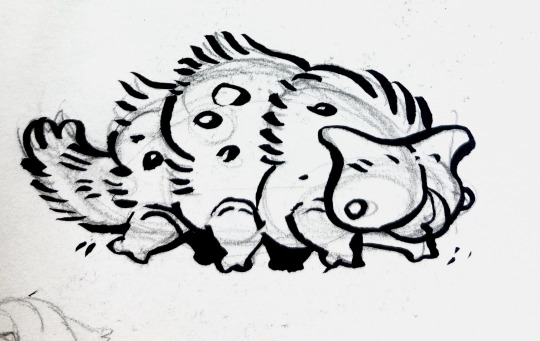
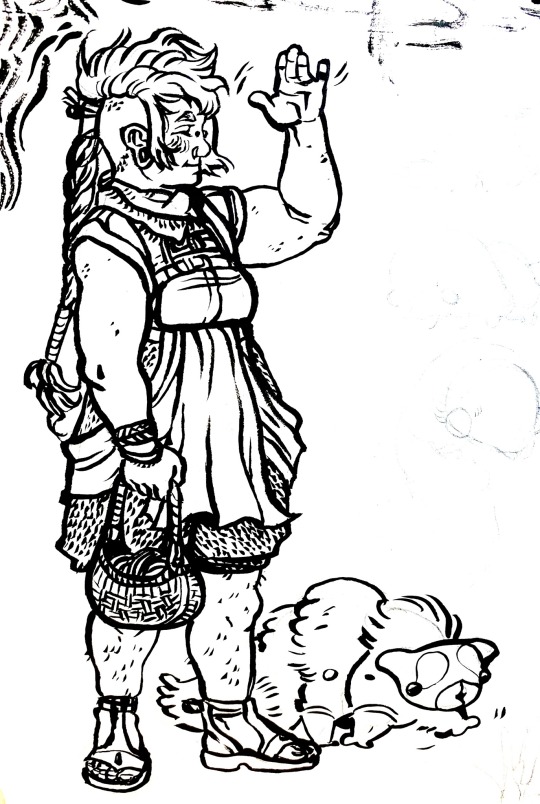
Wool-bearing larva and shepherd. These larva graze on grasses, moss and lichen. Their coarse wooly fibers can be harvested each time the larva sheds its skin to grow. The ancestors of these insects would molt and pupate on a yearly cycle, but shepherds care for them through winters to artificially extend the larval stage for year-round fiber harvests. When it is around three summers old it has a final, especially abundant molt with prized finely textured fibers, then it forms a hard chrysalis. It will overwinter in this state until the following spring, where it emerges as an adult to reproduce.
Shepherds store the chrysalises in cool, dry earth cellars for protection; the insects inside are essentially in stasis and can be harvested for meat throughout the winter with no worry about spoilage. After the first thaw, the fittest pupae are chosen to be that spring’s breeding stock, and the rest are culled and enjoyed as part of a seasonal feast.
#worldbuilding#creature design#fantasy species#world in progress#insects#speculative biology#livestock insects#wipworld humans#fantasy agriculture#wool-bearing larva#my art
111 notes
·
View notes
Text


Lepidopterans, the insect clade including butterflies and moths, were among the invertebrate species seeded onto the planet's biome, in order to act as pollinators that allowed the numerous introduced plants to survive. While most of them adhered to this lifestyle and ecological niche, as ravenous leaf-eaters that metamorphosed into flying pollinators, a few began to experiment with more unconventional lifestyles.
Some of the stranger kinds included the caterpedes: a group of neotenic species that matured simply as larger larvae and skip metamorphosis altogether: filling niches as forest floor detritivores, folivores or occasionally even predators of other insects. And perhaps more unusual are the clade known as the Hemimetamorpha, or "half-changed", which do pupate and emerge as adults with proboscises: yet retain their silk glands ejecting silk through a spinneret located directly below the proboscis and between the labial palps, allowing them to construct nests or wrap their eggs in silk sacs for protection.
Many of the Hemimetamorpha do not develop wings, and instead, thanks to their piercing and sucking mouthparts, fill the niches of true bugs on Earth: as sap-suckers akin to aphids, leafhoppers or cicadas, predators of small arthropods, or even as as flea-like parasites on larger animals. And in the case of one clade, the spooders, they use their retained silk glands to spin webs to catch their prey, in a manner akin to their arachnid namesake.
The red-spotted skeeter (Arachnopapilo rubrum) is one widespread Middle Temperocene species, ranging well across the tropics and temperate zones of Gestaltia and Arcuterra. Despite appearances, it sports two ocelli, one next to each compound eye, large feathery antennae possessing olfactory receptors, and a proboscis, albeit a short, sharp one rather than the long, coiled ones of nectar-feeders, all of which mark its lepidopteran ancestry despite the otherwise lack of resemblance to them.
Female red-spotted skeeters spin webs among grasses and branches, waiting to ensnare flying insects that they then immobilize with digestive enzymes in their saliva, while males are smaller and nomadic, instead hunting by pouncing on their prey and traveling across larger areas of territory compared to the more sedentary females who prefer to stay in their webs. They are also more brightly colored, in order to entice a mate, as the larger female is not above preying upon a suitor she does not like, though occasionally, a male may resort to restraining a female with his own silk, immobilizing her long enough to successfully mate and fleeing before she escapes.
Once mated, the female wraps her eggs into a silk pouch, searches out a safe place with plenty of food, and leaves the egg sac there to develop with no further intervention. The young hatch out as fairly typical caterpillars, yet are carnivores like the adults, tracking down and ambushing other small insects, in particular ants due to their foraging trails being a reliable source of food that comes to them as they lie in wait, as well as their toxic compounds being sequestered by the larva for its own defense. With a nutritious protein-rich diet, the larva matures faster than a leaf-eating caterpillar, and is ready to pupate within a week or two, producing a camouflaged chrysalis that is attached to branches and stems and further disguised by bands of silk. After another 5-7 days it emerges as an adult, and is immediately ready to hunt for a meal within minutes, being wingless and thus bypassing the long vulnerable phase of waiting of their wings to unfold. Within the span of a month, another generation is fully-fledged and ready to breed: a rapid turnover vital for a species with high mortality rates and many enemies-- including members of its own species in both their larval and adult forms.
------------
#speculative evolution#speculative biology#speculative zoology#spec evo#hamster's paradise#species profile
48 notes
·
View notes
Photo


Believe it or not, many Summoners have asked for a playable @MarvelChampions version of SPIDER-HAM. At last glance, Peter Porker ranked 54th most desired champ on the #MCOC community wishlist, with 111 Summoner upvotes. https://buff.ly/2E975sG
- Other Gabe
They have teased him only once!
- NΞWBY
#Spider Ham#recent rank#Spiderverse Hero#spiderverse#Earth 8311 Larval Earth#anthropomorphism#swine#variant#MCOCW page 3 51-75#Spider-Man: Into the Spider Verse#NΞWBY#IMNewby
2 notes
·
View notes
Text

Soon, a few Valkyrie came to deliver you to… wherever you needed to go. MAX walked alongside you, quietly thinking about something, most likely the information that had been levied his way. The walk itself was long. It felt oppressive, like you were on death row, each of your footsteps echoing down the long corridor you were being made to walk down. Soon, you found yourselves brought to a large chamber, and could feel several pairs of eyes staring down at you. The Lair Servants, each of them watching you like a hawk, as you stepped in. Seven Servants, sitting in loges looking down on you, as if the evening's entertainment had just wandered in.

CLEOPATRA: "Hi, Maxie. Looks like you're in a rather bothersome situation, huh?"
You watched as the Pharaoh leaned against her loge railing, waving down at MAX. He gave a casual wave back, before adjusting his glasses.
MAX: "Good evening, Pharaoh Cleopatra. And no, I've frankly never felt more comfortable."
You watched as the Keeper glared down at MAX, wizened brow furrowing as he locked eyes with the lawyer, who only shrugged in response.

PTOLEMAIOS: "Maxwell… what on Earth are you doing?"
MAX: "My job, Keeper. Same as you, I suppose."
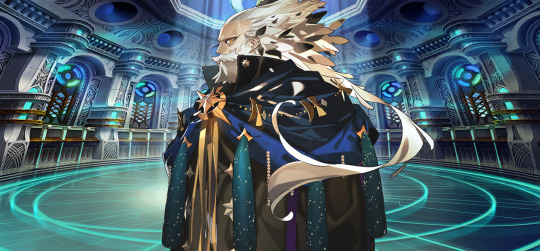
PTOLEMAIOS: "…Hrm. Right. Well, let us begin this Solar Council. With the exception of our missing allies, let's take the roll..."
His eyes glanced over three missing sections, and you could see a brief moment of weariness in his expression before it hardened once again.
PTOLEMAIOS: "...I, Keeper Ptolemaios, am present."
The next Lair Servant spoke. Her voice was more recognizable than her appearance, at first. Gone was the veil, but the calm, yet condescending tone remained as you looked upon the administrative body that had put you through so much grief early on.
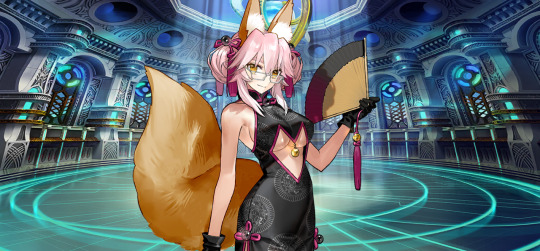
ADMINISTRATOR: "Via proxy, the Priestess of the Heavenly Divinity is present."
One after another, the others called their names.
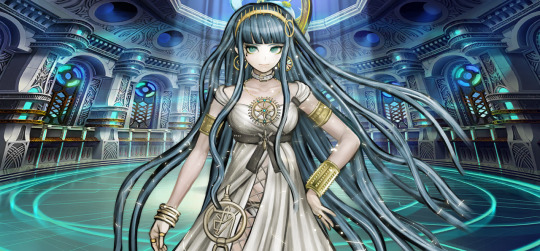
CLEOPATRA: "Pharaoh Cleopatra, present."
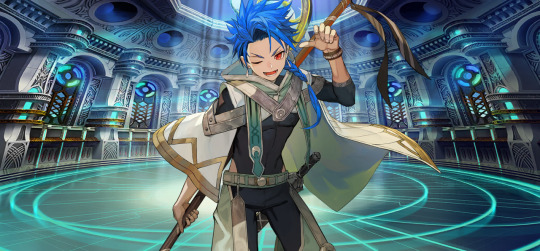
SETANTA: "Yo, Beastmaster Setanta is here!"

SIGURD: "Freyr Sigurd and Freya Brynhildr are both present."
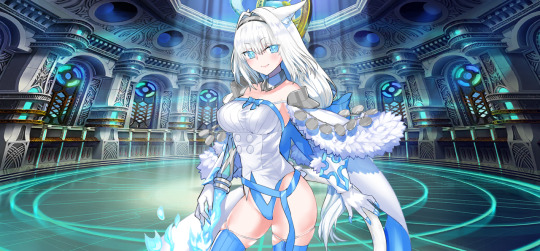
NIKITICH: "Slayer Dobrynya Nikitich, present."
She leaned against her loge, looking around at the other Lair Servants.

NIKITICH: "We don't often meet like this, do we? As nice as it is, I would like to make this quick, before the next set of fights start."
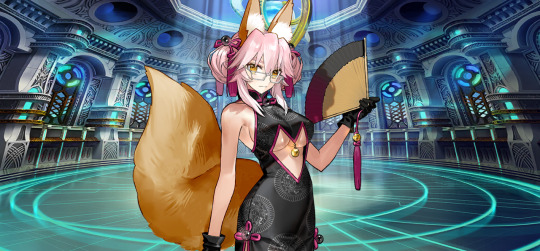
ADMINISTRATOR: "Your presence is always appreciated, Slayer. And this topic should be one of quick simplicity, we're simply going to decide whether we'll slaughter these heathens where they stand."
She said it so casually, it was almost easy to miss that she just declared you on trial with punishment for execution. Or, scratch that, no trial- just a decision of execution.
You heard SIGURD speak up, his low voice stern and authoritative, in immediate protest.
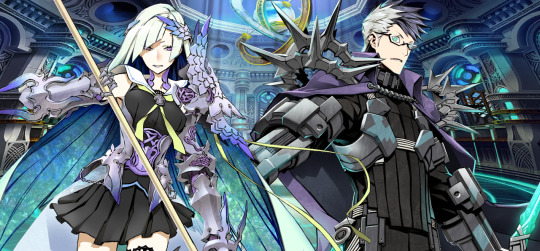
SIGURD: "Now, wait just a moment. That's not what we discussed. We're here to discuss the Beast and the Nameless City."
You watched as BRYNHILDR spun her spear, pointing it towards at the ADMINISTRATOR with aggravation.
BRYNHILDR: "…My younger sisters did not apprehend the Interlopers for them to be killed. You can't simply change the details of the proceedings at the last minute...!"
The ADMINISTRATOR lazily looked over at him, giving him a coquettish grin as she idly waved her fan in SIGURD and BRYNHILDR's direction.

ADMINISTRATOR: "I'm not. This is still fully within the context of the Beast situation, however I am making our perspectives more efficient and focusing on the source. If we didn't, we'd be pointing fingers all day, and we're all such busy people. So, I am rephrasing our current agenda. Due to the recent tragedies that have befallen the Solar Cell, including the Larval Beast attack-- do we allow the Interlopers to remain free, or do we kill them here and now. The answer is so obvious, it may surprise you~! But if you need help, it starts with 'kill' and ends with 'them'. Any objections?"
You watched as the Freyr and Freya were the only ones to lobby an objection, as the rest of Lair Servants remained as they were, their silence outvoting the rulers of the Nameless City. The ADMINISTRATOR flipped the fan up to cover her mouth, covering her sneer rather poorly.

ADMINISTRATOR: "Isn't voting wonderful?"
You heard a low, amused whistle come from SETANTA's loge.

SETANTA: "Going straight for the jugular. You foxes don't mess around."

NIKITICH: "So those are the feared Interlopers? They are… ah, how to say it… 'scrawny'? These are the ones that impaled Uesugi Kenshin upon her own pagodas? They could not survive one swing of Nikitich's axe, in my eyes."
A frustrated huff, as the Pharaoh across from her looked down on you, her gaze a bit more discerning.

CLEOPATRA: "They say appearances can be deceiving. Strength is found in ways other than musculature… that was how they infiltrated the Solar Cell before, right? Ptolemaios?"
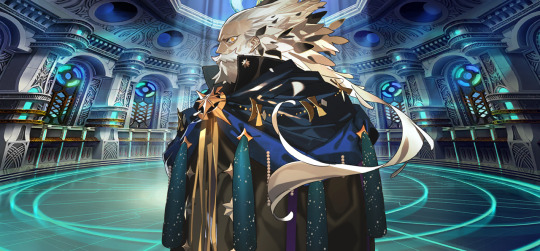
PTOLEMAIOS: "…That is correct. We let our guard down once, Cleopatra. Never again."
His gaze on you, already intense, seemed to grow stronger as he stared deeper and deeper into you. You watched as MAX, undeterred, looked around the chamber, before his eyes settled on the ADMINISTRATOR.

MAX: "I would have expected the current presiding Priestess to be here rather than you, Madame Administrator. Was Priestess Aria busy?"
ADMINISTRATOR: "You think that Aria would be able to sit through one of these and not fall asleep? I love the girl, but she's far from the most attentive of us. Now, enough casual chatter, and let's get started with the voting."
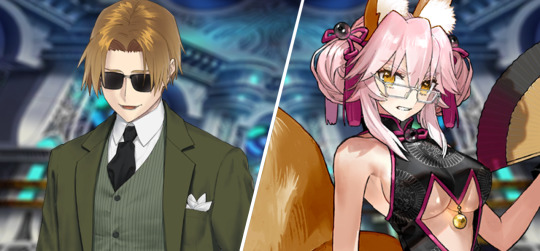
MAX: "Hold on- this is a trial, is it not?"
ADMINISTRATOR: "…Is it? I see no reason for it to be. This is rather open and shut."
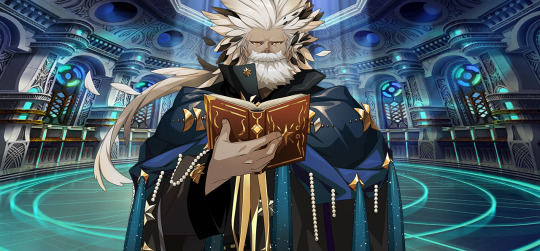
PTOLEMAIOS: "He's right. This is a trial. They're entitled to make a case. Interlopers of the Solar Cell, revived again and set loose again. You're being given a rare chance, and so you'll have a few minutes to prepare your statement. Choose your words wisely."

MAX: "Thank you, Keeper Ptolemaios."
MAX nodded, before leaning closer to you, speaking quietly and calmly.

MAX: "...High stakes. High difficulty. But remember, not impossible."
34 notes
·
View notes
Text
You know what. I hate Godzilla x Kong: The New Empire.
I'll never forgive Wingard for how insignificant he made Mothra be in The New Empire, and how much he messed up the little bit of lore we had established from KOTM.

Less than two minutes of screentime?
Enough that you can forget she was even in the movie even with the characters mentioning having to bring her back every thirty minutes?
Why does she need a human to be reborn? That takes away so much of her mysticism. Before we assumed that Mothra could feel it was time for her to be reborn. Like she was always aware of something deeper, like she was connected to the Cosmos itself.
Now she needed a human? Specifically from Skull Island? How would the Iwi, who were in the deepest parts of the Hollow Earth for however many years, even KNOW about Skull Island? Ffs the more you think about the movie the more it falls apart. Everything is held together by stitches.
And I was so looking forward to seeing Mothra's cute larval form. She looks like a Tardigrade. But Mothra wasn't meant to be in the movie and Wingard had to lie through his teeth to say she was the original plan. I don't trust him with hers or Godzilla's characterizations.

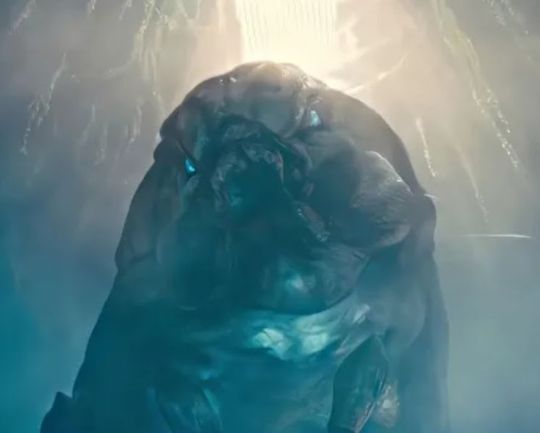
Don't even get me started on how obvious it is that she was just shoved into the movie with animations and sounds that fit a peacock better (Like what Fosphera was going to be with those feathers).

The bird sounds are so out of place with her reused sounds from KOTM. Those ones are based on whales and dolphins.

This discussion on Reddit actually reassured me a little bit when it comes to Mothra's lore: https://www.reddit.com/r/Monsterverse/comments/1d6g41i/adam_wingards_take_on_gxk_mothra_explained/
Thank you for the explanation @/thebeastunleashed !
55 notes
·
View notes
Text
I have had a few theories about pupa under my belt.
I had a theory that the Shlorpians found the species of the pupa and genetically modified them into “super computers” to terraform planets. When they were working with them, they were actually modifying them on a biological levels and testing their abilities. I have a second connecting theory about how the Shlorpians made/found pupas; What if they are just genetically modified shlorpians? They could’ve changed the genetic make up from plant-based life to some I entirely different. Or maybe they are a species that originated from their planet that they modified heavily. Slugs and plants 😉
Since the pupa is in the transformation stage, when it grows up and doesn’t terraform the planet, how do we think he will look? When I think pupa, I think of the larval or cacoon stage of the bug cycle. Since we know, pupa loves his family and isn’t going to destroy the planet because of his evolution being tainted, what are some ideas of how he will grow and change?
What if being “ tainted” by earth, is actually him being broken from the Shlorpians bio code? What if he ends up evolving, and growing like his species normally would because he has been treated as an equal to the team (for the most part…) and growing as a child should be?
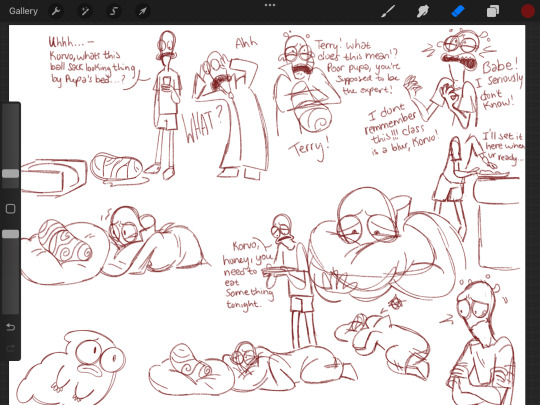
#solar opposites tervo#solar opposites fanart#solar opposites terry#solar opposites#solar opposites korvo#solar opposites pupa#solar opposites au#solar opposites theory#fan theory#concept art#comic art#sketching#tervo#terry opposites#korvo opposites
133 notes
·
View notes
Text
Wet Beast Wednesday: aquatic insect larvae
This Wet Beast Wednesday is going to be different than usual. Instead of an in-depth overview of a specific species or group of species, I'm going to give a general overview of aquatic insect larvae as a whole and then showcase some groups of insects. I'm going to focus on insects that have an aquatic larval stage and terrestrial adult stage, saving adult aquatic insects for another post.
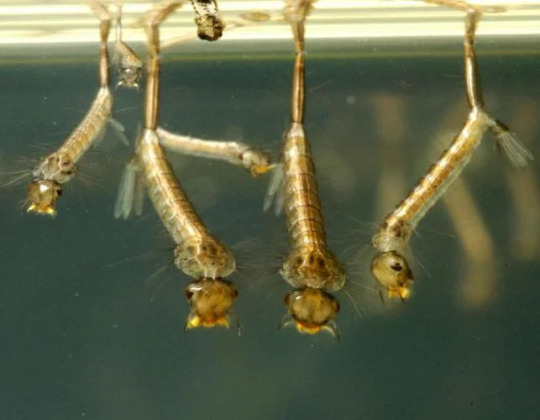
(Image ID: a group of mosquito larvae. They are yellowish bugs with long, slender bodies, no visible limbs, small heads, and feathery appendages from their rear ends. From the back of the abdomen, a snorkel-like appeadage attaches to the surface of the water, using surface tension to allow the larvae to hang from the surface. End ID)
Insects are basically the most successful group of animals in the history of life on Earth and have adapted to live in just about every terrestrial habitat. It should not be much of a surprise than that they have also moved into the water. More specifically, fresh water as almost all aquatic insects inhabit fresh or maybe brackish water. Only the water strider genus Halobates are truly marine. Some species of insect are aquatic for their entire lives, some are primarily terrestrial but able to swim, and some are aquatic only for their larval stage of life. These aquatic larvae species are generally agreed to have evolved from fully terrestrial ancestors. The adaptation of partially returning to the water has evolved independently many times in many different clades of insect and so different species use different strategies and adaptations. It is possible that aquatic larvae evolved in response to high competition for resources on land. If multiple species are competing over the same resources during their larval stages but one of those species manages to adapt to a whole new environment, that species will now have abundant access to resources the other species are unable to get to. Because of the very different lifestyles required for aquatic and terrestrial animals, aquatic larvae often look very different than their adult forms.
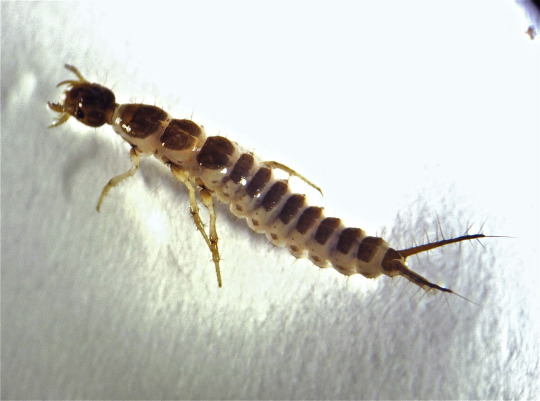
(Image: an aquatic beetle larva. It looks nothing like an adult beetle, instead being a long, slender insect with no wings, multiple body segments, and two hairy appendages at the base of the abdomen. End ID)
Aquatic larvae serve important roles in their ecosystems. Many are herbivores or detritivores that consume algae and bits of biological material, helping recycle nutrients and clean the water. Some are predators that hunt smaller invertebrates or plankton. Importantly, aquatic insect larvae provide a major food source for larger fish, invertebrates, birds, and so on. Some species can be considered keystone species, vital to their ecosystems. Many species are highly sensitive to changes in their environment, allowing them to act as indicator species for the health of their ecosystems. The trio of mayflies, stoneflies, and caddisflies are very commonly used as indicators of pollution as all three are highly sensitive to pollutants. A stream with few mayflies, stoneflies, or caddisflies but plenty of less sensitive species is likely to be polluted.
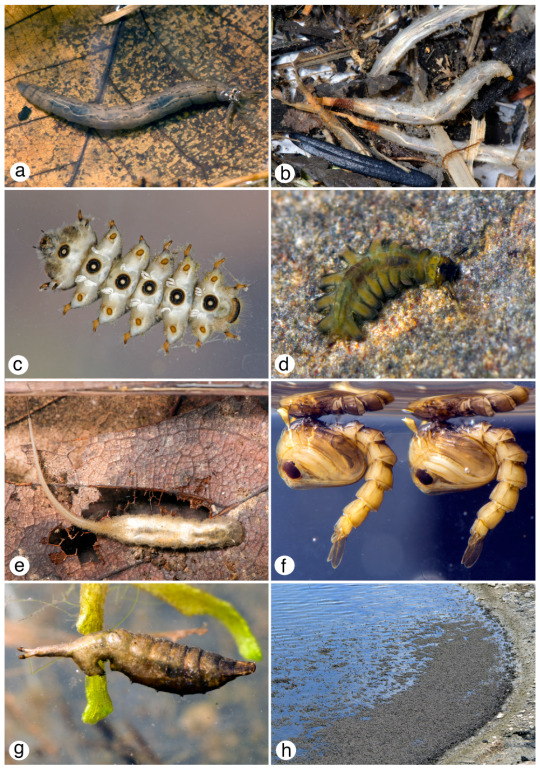
(Image ID: a collage of aquatic larvae of multiple species in the order Diptera (true flies. They vary from slug-like to having multiple distinct body segments with legs, to looking like maggots with long tails. End ID. Source)
Mayflies (order Ephemeroptera) are among the oldest lineages of winged insects, bearing traits that they first flying insect also had. Juvenile mayflies are technically not larvae, but nymphs. The difference between a larva and a nymph is that nymphs look much more like the adult stage than larvae do. Mayfly nymphs lack the wings of adults, but have external gills growing from the sides of their abdomens. Mayfly nymphs can be identified by three appendages called cerci that emerge from the back of the abdomen. They are bottom-dwellers that typically live under rocks and other objects or amid plants. Most are herbivores, feeding mainly on algae. Months to years after hatching (species dependent), mayflies will float to the surface and go through a molt to a stage called the subimago. Uniquely among insects, mayflies go through two final winged molts. The first is to a not sexually mature stage called the subimago, then they quickly molt again into a fully mature imago stage. These molts happen in sync, resulting in hundreds to thousands of mayflies appearing all at once and swarming together to mate. Famously, adult mayflies exist only to mate and die. Their digestive systems are non-functional and few species last past a few days.

(Image: a mayfly nymph on a rock. It is a yellow bug with no wings, a long abdomen, and thick, grasping legs. Three long, hairy cerci emerge from the back. Along the side of the abdomen are multiple pairs of white, feathery gills. End ID)
Stoneflies (order Plecoptera) also have nymphs and can be quite difficult to tell apart from mayfly nymphs if you don't know what to look for. One of the biggest differences is that their gills are located by the base of the legs rather than along the abdomen. Like mayflies, stoneflies are some of the most primitive winged insects, but mayflies are Paleopterans (the earliest wings insects) while stoneflies and most other winged insects are Neopterans. The main difference is that Neopterans can flex their wings over their abdomens while Paleopterans cannot, and must hold their wings either out to the side or up in the air. Like with Mayflies, many adult stoneflies have nonfunctional digestive systems and exist only to mate and die.

(Image: a stonefly larva. It looks similar to a mayfly larva, but has a shorter abdomen, gills along the base of the legs, and only two cerci. End ID)
Caddisflies (order tricoptera) are the builders of the aquatic insect world. These larvae (most species anyway) can produce silk from glands near their mouths. These are used to make a variety of structures made from silk and various other materials including sand, silt, plant parts, shells, rock, and so on. Different species will seek out specific materials for their structures. There are a few types of structures, the most common of which is a tubular case that is open at both ends. The larva can carry the case with it as it crawls around and can retreat into the case for protection. The larva can draw water into one end of the case and out the other, allowing oxygenated water to flow over the gills. By moving around in the case, the larva can draw in more water. This allows the larvae to survive in water that is too oxygen-poor for other larvae. Other species build different structures including turtle-shell like domes or stationary retreats. My favorite structures are nets built with an open end into current. The current naturally brings detritus and micro-invertebrates into the net, where the larva can eat them. Caddisflies also pupate into pupa that have mandibles to cut their way out of their cases and swimming legs. Once developed, the pupae swim to the surface and molt into their adult forms. This molting is synchronized to ensure the adults emerge in swarms and can easily find mates.
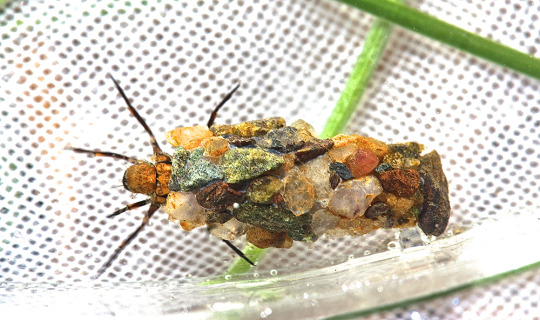
(Image ID: a caddisfly larva in its case. The case is a tube composed of pebbles of different colors stuck together with silk. The head and legs of the larva are merging from the front of the case. End ID)
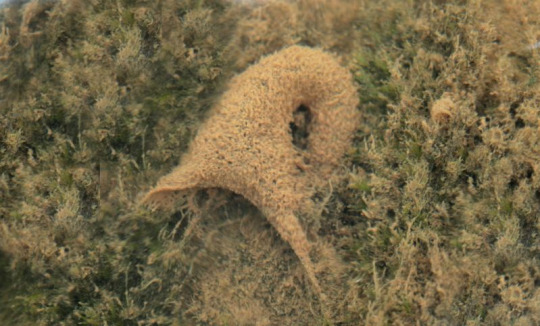
(Image: a caddisfly net. It is a structure made of silk shaped like a tube that is wide at one end and tapers toward the other. It is curved so both ends face the same way. End ID)
The order Megaloptera consists of alderflies, dobsonflies, and fishflies. All three have aquatic larvae, but their eggs are laid on land. Most species lad their eggs on plants overhanging the water so the larvae fall in once hatched, though a few lay eggs near the water's edge, forcing the larvae to crawl in. Meglaoptera have the least amount of differences between larva and adult of all holometabolous (pupa-forming) insects. The largest differences between the larvae and adults is the larvae lack wings and some species have leg-like prolegs. All species are carnivorous as larvae and feed on other invertebrates.
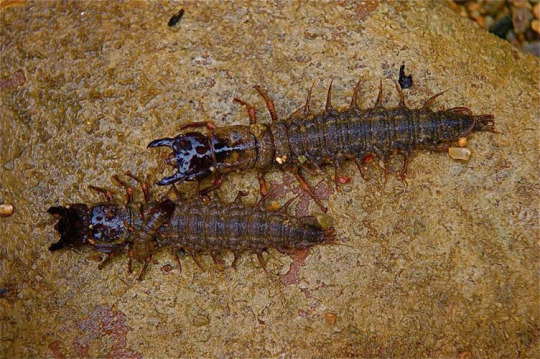
The adults don't look any less creepy
(Image: two hellgrammites, the larval form of a dobsonfly. It looks somewhat like a centipede with three pairs of limbs and a long abdomen with multiple pairs of leg-like prolegs. The head has no visible antennae, but does have a pair of powerful pincers. End ID)
Order Odonata consists of dragonflies and damselflies. These are powerful predators both as nymphs and adults. As nymphs, the juveniles are shorter and stockier than the adults, with no wings. The nymphs (or naiads) breathe through gills. In damselflies, these gills can be external, but dragonfly nymphs have their gills located in the anus. Damselflies can swim by undulating their gills, but dragonfly nymphs are restricted to crawling. The nymphs are voracious predators that will feed on anything they can catch. Most of their diet consists of invertebrates, but they will also attack small fish, tadpoles, and even salamanders.
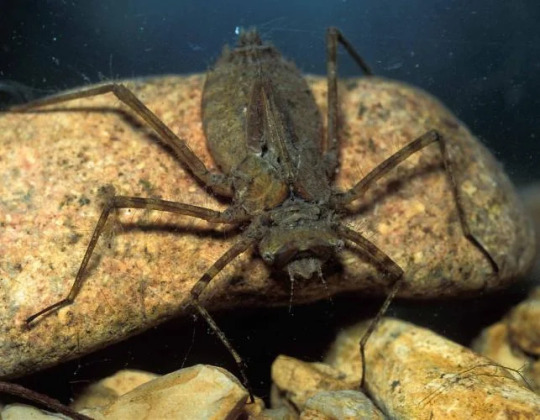
(Image ID: a dragonfly larva on a rock. Its head is similar to that of the adults, but the abdomen is much shorter and broader and the legs are longer. It has no wings and is brown all over. End ID)
The groups of insects I covered today (plus the stoneflies) all have exclusively or near-exclusively have aquatic larvae while the adults are terrestrial. In other groups, aquatic larvae may be present in some species while others have terrestrial larvae. For example, a great many members of the order Diptera (true flies) have aquatic larvae including all mosquitos, while other members of the order have fully terrestrial larvae. In addition there are species of beetle (order Coleoptera), moth (order Lepidoptera), lacewing (order Neuroptera), and scorpionflies (order Mecoptera) that have aquatic larvae and some species of the true bugs (order Hemiptera) have aquatic larvae and aquatic adults, including water skaters, water scorpions, and giant water bugs. Aquatic insects are so prevalent that it is rare to find any lasting body of water that doesn't host some aquatic larvae or adults. Even incredibly stagnant and filthy water can host aquatic insect larvae, as shown by the notorious rat-tailed maggots, who love stagnant water and breathe through snorkels. Many species require very specific conditions and there are species of insect who exclusively grow their larvae in specific streams or lakes. Because of this, conservation of these bodies of water is vital to their survival and pollution, damming, and other factors can destroy whole species.
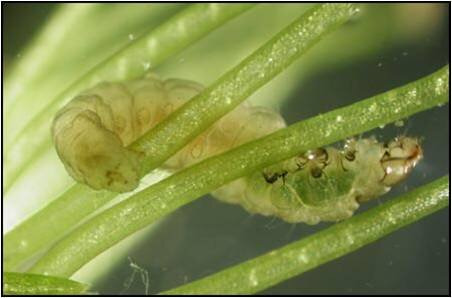
(Image: an aquatic moth larva. It looks very similar to a green land caterpillar, with none of the fancy elements many land species have. It is translucent and wrapped around some aquatic plant stems. End ID)
#wet beast wednesday#insects#insect larvae#aquatic insect larvae#larva#pupa#mayfly#stonefly#caddisfly#dobsonfly#hellgrammite#dragonfly#damselfly#freshwater ecology#ecology#biology#zoology#invertebrate#invertebrates#animal facts#informative#bug#bugs
76 notes
·
View notes
Text

so i got two different versions of the "leviathan au." one where it's a whole different situation from regular (not-a-game) HLVRAI, in which gordon and benry first meet when gordon is test driving an experimental exploration sub for black mesa... and another one where it follows along with the regular not-a-game AUs, and the leviathan is benry's true form. this second version also follows my headcanon that benry really was 'born' in 1994 (and is just a year younger than gordon).
benry hatched from an egg that had crashed down onto earth over a hundred years ago, and the crator its impact made turned into a small lake over time.
(the entity that laid that egg had been... dealt with by the overly territorial mr. coolatta, along with the rest of the clutch. unfortunately for mr. coolatta, he missed one egg. and said egg would prove to be a major headache source for him yeaaaars in the future.)
in the early morning of january 1st, 1994, the egg finally hatched, and a little larval space squid dragon crawled out. he remained in that lake for five years, curious about the world and other creatures beyond its shore, but always too nervous to leave the safety of his cradle.
until one day, when a smaller version of some of the beings benry had sometimes seen hanging around the lake finally spotted him. and gave him a candy bar.
this version of the AU uses the whole 'gordon and benry really DID know each other as kids' idea, and in this case, they knew each other over the course of one summer. lil six-year-old gordon and his family were spending the summer at a relative's lakeside home, and while exploring the lake beach, gordon encounters and soon befriends a 'lake monster'. (all the adults of course write the kid's tales of his new lake monster friend as a child's wild imagination, naturally.)
communication between the two of them is at first pretty one-sided, which doesn't bug gordon much cause he's pretty sure his new friend 'Sparkly' is just an animal (monsters are a kind of animal, duh) so he's not expecting sparkly to understand him. gordon is at least able to understand how 'sparkly' is feeling, though, as the weird rainbow bubbles he sings out make gordon feel things that don't feel like his feelings. which he thinks is really weird but also kinda cool and he wishes his cat missy could do that.
benry is eventually able to finally really understand what gordon's saying, once he's able to briefly make a mental connection with the human. VERY briefly. just long enough to get an understanding of the following things:
the english language (at a six-year-old's level at least).
that his new friend's species are called humans.
that humans don't think things like him exist, and would freak out if proven otherwise. this is why gordon won't let benry follow him when the bigger humans call him to come back to the big boxy shelter.
video games are a thing and apparently super fun. benry would like to try video games. pushing buttons to make a lil guy on a picture box do stuff, as if you were the little guy. sounds neat!
if benry wants to do anything outside of his lake without having to hide all the time, he needs to look less like himself and more like a human (looking like a human will also make talking like one easier. can't really form a lot of the sounds they make with just a beak.)
unfortunately, this didn't happen until like a day or two before gordon had to go back home. but gordon told benry that he'd be back next year! he'll think up a ton of new stuff for them to do until then!
...doubly unfortunately, sometime late fall of that year, black mesa finally finds benry and takes him down to their facility in new mexico. so the next year that gordon's family goes to visit at the lake in summer again, gordon gets no response when he calls out to 'sparkly,' no matter how many times he does. after a time he gives up, accepting that his lake monster friend is gone, and then eventually even forgets he ever existed, believing any memories to be imaginary friend stuff, like his mom and relatives always assumed.
benry didn't forget, though.
...but he did forget what he orginally looked like. not long after gordon's family left, benry got to work on practicing looking human. the hands were the easiest part, he already had hands like that, he just had to get rid of one finger (why humans only got five??). arms and torso were no biggie either, really. the hard part was the head and legs. legs weren't toooo hard to figure out, they were kind of like arms, sorta, but human heads and his head are SO different, like, wow. that took a while.
by the time black mesa had found him, he was looking mostly human. but not enough to trick anybody. especially not anybody with ways to detect the cosmic energy his body radiated.
black mesa never knew about benry's true form, as he never went back to it once during his captivity (and eventual employment for good behavior) at the facility, and eventually benry himself even forgot what he really looked like... which could possibly be blamed on some of the experiments conducted on him. his memory may be a bit wonk in some regards, but it's not THAT bad.
it's not until after the big beatdown in xen that he finally starts to remember... he respawns, but in that midform, rather than his usual human disguise form.
he's unable to try and shift further, as the 'containment' mr. coolatta mentioned turns out to be a whole new research facility that black mesa sold benry off to in order to secure extra funds for repairing and rebuilting their own labs.
this new place, Lancer Labs, seems to have gotten the same weird 'dampening field' that 'mesa had to keep benry's powers nerfed.
the scientists at lancer are also not as 'nice' as black mesa's, if you can believe that.
benry's stuck there for a year, being as uncooporative as he possibly can. lancer has been able to learn all they can from examining his body, but they have made like 0 progress with mental/behavioral studies, and they're starting to get real tired of benry's shit. so upon reviewing various files and reports they got from black mesa, including some recordings from during the rescas, the researchers at lancer labs get an idea for something that might finally get their prized specimen to stop being a stubborn ass.
in the middle of the night, gordon freeman is abducted from his own home.
they could tell from some of the rescas recordings, that benry seemed to be rather fond of the humans he was travelling with. lancer is going to use gordon as a barganing chip.
benry had become pretty listless and dejected during his new captivity, but seeing gordon get dragged into this shit was the kick in the pants his drive to escape needed. gordon may have been a big jerk, but he doesn't deserve being locked up in a lab for the simple crime of knowing benry.
benry just has to wait for the right moment to break outta here....
26 notes
·
View notes